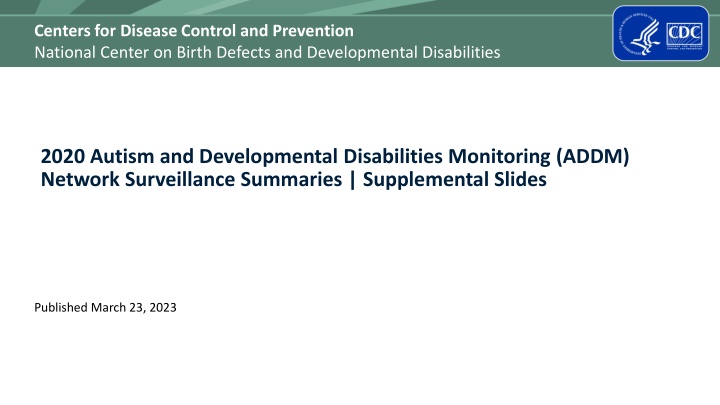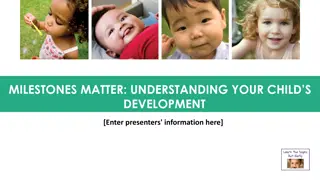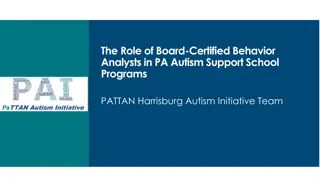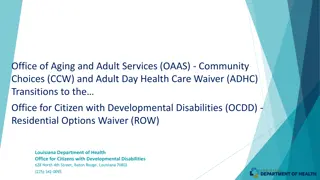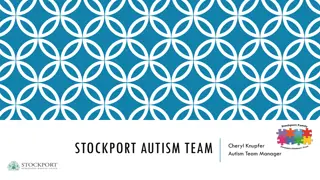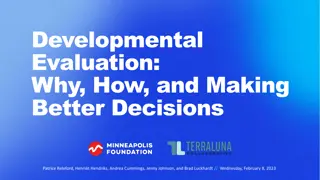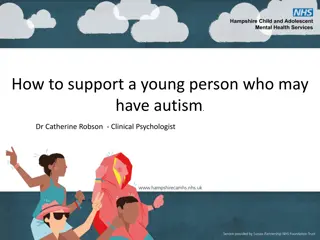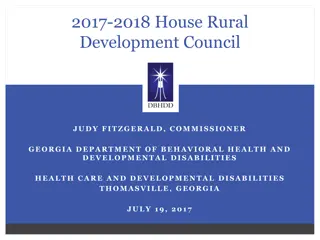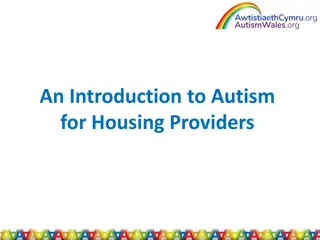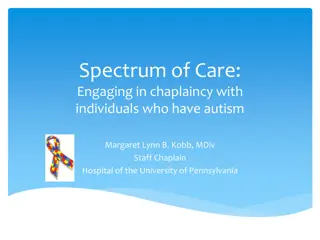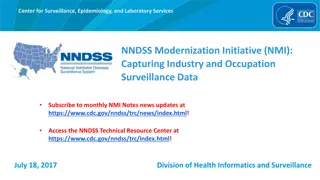Autism and Developmental Disabilities Monitoring Network 2020 Surveillance Summaries
The Autism and Developmental Disabilities Monitoring Network conducted surveillance in 2020 across 11 sites in the United States to track the prevalence and characteristics of autism spectrum disorder (ASD) among children aged 4 and 8 years. Data was collected through various sources including health and education records, billing codes, and diagnostic criteria. The network also defined case definitions for ASD and intellectual disability, utilizing documentation such as written diagnoses, special education classifications, and IQ scores. Additional data sources were incorporated to provide a comprehensive overview of ASD prevalence and associated factors in the population.
Download Presentation

Please find below an Image/Link to download the presentation.
The content on the website is provided AS IS for your information and personal use only. It may not be sold, licensed, or shared on other websites without obtaining consent from the author.If you encounter any issues during the download, it is possible that the publisher has removed the file from their server.
You are allowed to download the files provided on this website for personal or commercial use, subject to the condition that they are used lawfully. All files are the property of their respective owners.
The content on the website is provided AS IS for your information and personal use only. It may not be sold, licensed, or shared on other websites without obtaining consent from the author.
E N D
Presentation Transcript
Centers for Disease Control and Prevention National Center on Birth Defects and Developmental Disabilities 2020 Autism and Developmental Disabilities Monitoring (ADDM) Network Surveillance Summaries | Supplemental Slides Published March 23, 2023
2020 ADDM Surveillance Summary Citations and Links Maenner MJ, Warren Z, Williams AR, et al. Prevalence and Characteristics of Autism Spectrum Disorder Among Children Aged 8 Years Autism and Developmental Disabilities Monitoring Network, 11 Sites, United States, 2020. MMWR Surveill Summ 2023, 72 (No. SS-2): 1-14. Shaw KA, Bilder DA, McArthur D, et al. Early Identification of Autism Spectrum Disorder Among Children Aged 4 Years Autism and Developmental Disabilities Monitoring Network, 11 Sites, United States, 2020. MMWR Surveill Summ 2023, 72 (No. SS-1): 1-15.
Autism and Developmental Disabilities Monitoring Network, 11 sites, United States, 2020
ADDM Ascertainment and ASD Case Definition Records that included various billing codes from the International Classification of Disease, Ninth Revision (ICD-9) or International Classification of Diseases, Tenth Revision (ICD-10) or special education eligibility codes were requested from health and education sources. Children ages 4 or 8 who had a parent or guardian who lived in one of the surveillance areas during 2020 were classified as having ASD or suspected ASD if they met the below criteria. ASD case definition Suspected ASD case definition Child has documentation of ever receiving: 1) a written ASD diagnosis by a qualified professional, 2) a special education classification of autism, OR 3) an ASD ICD code obtained from administrative or billing information (4-year-old only) Child does not meet criteria of full case definition but there is a qualified examiner s diagnostic statement that the child is suspected of having ASD
ADDM Intellectual Disability Case Definition Co-occurring intellectual disability was classified as: 1. IQ score 70 on most recent test 2. examiner s statement of intellectual disability in a developmental evaluation
ADDM Additional Data Sources and Variable Definitions National Center for Health Statistics population estimates for 2020 were used as denominators. Estimates for areas smaller than county level were adjusted using National Center for Education Statistics public school enrollment counts for 2020-2021. Sites linked American Community Survey 2020 5-year estimates for median household income (MHI) to records of children using their 2020 address. Census tracts for all sites combined were grouped into low, middle, and high MHI tertiles that included roughly equal populations of children.
ADDM Analytic Methods Prevalence was calculated as the number of children with ASD per 1,000 children in the defined population or subgroup. Cumulative incidence for children aged 4 years was compared with children aged 8 years in the ADDM Network. Cumulative incidence of ASD diagnosis was calculated per 1,000 children by dividing the total number of children with an ASD diagnosis or special education eligibility at each month of age by the 2020 age 4 or age 8 population denominator.
ADDM Analytic Methods COVID-19 analysis Numbers of evaluations and ages of earliest identification were aggregated by calendar month for children aged 4 and 8 years in 2020. To compare the same age windows by calendar month, the numbers of evaluations and incidence of identification from 2012 (year 0) through 2016 (year 4) for children aged 8 years was subtracted from the same months during 2016 (year 0) through 2020 (year 4) for children aged 4 years.
2020 Prevalence of Autism Spectrum Disorder Among Children Aged 8 Years Autism and Developmental Disabilities Monitoring Network 11 Sites, United States
Prevalence* of autism spectrum disorder per 1,000 children aged 8 years, by identification type and site Autism and Developmental Disabilities Monitoring Network, 11 sites, United States, 2020 * Horizontal line is the overall Autism and Developmental Disabilities Monitoring Network prevalence of 27.6 per 1,000 children aged 8 years. Children with documented ASD statements could also have ASD classifications in special education or ASD ICD codes.
Euler diagram of different types of autism spectrum disorder identification among children aged 8 years with autism spectrum disorder (N=6,245) Autism and Developmental Disabilities Monitoring Network, 11 sites, United States, 2020
Prevalence of autism spectrum disorder per 1,000 children aged 8 years, by race/ethnicity Autism and Developmental Disabilities Monitoring Network, 11 sites, United States, 2020
Prevalence of autism spectrum disorder per 1,000 children aged 8 years over time, by race/ethnicity Autism and Developmental Disabilities Monitoring Network, 11 sites, United States, 2002 2020
Percent of children aged 8 years with autism spectrum disorder with co-occurring intellectual disability*, by sex and race/ethnicity Autism and Developmental Disabilities Monitoring Network, 11 sites, United States, 2020 * IQ score 70 or examiner statement of intellectual disability in a comprehensive evaluation
Prevalence* of autism spectrum disorder per 1,000 children aged 8 years, by median household income tertile and site Autism and Developmental Disabilities Monitoring Network, 11 sites, United States, 2020 * Dots are the point estimates and horizontal lines are the 95% confidence intervals. Cochran Armitage test of trend results for association between socioeconomic status tertile and ASD prevalence, by site and overall: Arizona p = 0.03; Arkansas p = 0.3; California p = 0.5; Georgia p = 0.08; Maryland p = 0.9; Minnesota p = 0.8; Missouri p = 0.3; New Jersey p<0.01; Tennessee p = 0.1; Utah p<0.01; Wisconsin p = 0.08; Total p<0.01.
Prevalence of autism spectrum disorder per 1,000 children aged 8 years, by surveillance year Autism and Developmental Disabilities Monitoring Network, 2000 2020
2020 Early Identification of Autism Spectrum Disorder Among Children Aged 4 Years Autism and Developmental Disabilities Monitoring Network 11 Sites, United States
Prevalence* of autism spectrum disorder per 1,000 children aged 4 years, by identification type and site Autism and Developmental Disabilities Monitoring Network, 11 sites, United States, 2020 * Horizontal line is the overall Autism and Developmental Disabilities Monitoring Network prevalence of 21.5 per 1,000 children aged 4 years. Children with documented ASD statements could also have ASD classifications in special education or ASD ICD codes.
Comparison of prevalence of children aged 4 years with autism spectrum disorder (ASD) vs suspected ASD, by site Autism and Developmental Disabilities Monitoring Network, 11 sites, United States, 2020
Prevalence of suspected autism spectrum disorder per 1,000 children aged 4 years Autism and Developmental Disabilities Monitoring Network, 11 sites, United States, 2018 and 2020 * Higher if 2020 to 2018 prevalence ratio 95% CI excludes 1.0.
Euler diagram of different types of autism spectrum disorder identification among children aged 4 years with autism spectrum disorder (N=4,896) Autism and Developmental Disabilities Monitoring Network, 11 sites, United States, 2020
Prevalence of autism spectrum disorder per 1,000 children aged 4 years, by race/ethnicity Autism and Developmental Disabilities Monitoring Network, 11 sites, United States, 2020
Cumulative incidence of autism spectrum disorder diagnosis or eligibility per 1,000 children aged 4 or 8 years Autism and Developmental Disabilities Monitoring Network, 11 sites, United States, 2020
Cumulative incidence of autism spectrum disorder diagnosis or eligibility per 1,000 children aged 4 or 8 years, by site Autism and Developmental Disabilities Monitoring Network, 11 sites, United States, 2020
Difference in number of developmental evaluations and incidence of autism spectrum disorder identification per 1,000 children for children aged 4 years in 2020 during calendar years 2016 2020 and children aged 8 years in 2020 during calendar years 2012 2016, by month Autism and Developmental Disabilities Monitoring Network, 11 sites, United States, 2020
End Slide For more information, contact CDC 1-800-CDC-INFO (232-4636) TTY: 1-888-232-6348 www.cdc.gov The findings and conclusions in this report are those of the authors and do not necessarily represent the official position of the Centers for Disease Control and Prevention.
